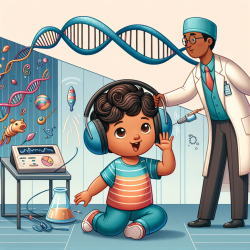Introduction
In the realm of pediatric audiology, timely and accurate diagnosis of hearing loss is crucial for effective intervention and management. The recent study titled "Development of in-house genetic screening for pediatric hearing loss" by Doerfer et al. (2020) presents compelling evidence on the benefits of implementing in-house genetic testing for sensorineural hearing loss (SNHL) in children. This blog aims to elucidate the findings of this research and encourage practitioners to consider adopting in-house genetic screening to enhance diagnostic efficiency and outcomes for children with hearing impairments.
Research Findings
The study conducted a retrospective cohort analysis of 200 pediatric patients with suspected or confirmed hearing loss. It compared the turnaround times of send-out genetic tests versus in-house genetic tests for mutations in genes such as GJB2/GJB6, SLC26A4, and MTRNR1. The results were significant: the mean turnaround time for send-out testing was 53.7 days, whereas in-house testing averaged just 18.9 days. This reduction in time was statistically significant (P < .001), highlighting the efficiency of in-house testing.
Moreover, the study identified two audiometric parameters that could enhance the diagnostic yield of genetic testing: bilateral newborn hearing screen referrals and audiometry showing symmetric SNHL. These parameters can help clinicians pinpoint which patients are most likely to benefit from genetic testing, thus streamlining the diagnostic process.
Implications for Practice
For practitioners in the field of pediatric audiology and speech-language pathology, these findings underscore the importance of integrating genetic testing into routine diagnostic procedures. The reduced turnaround time for in-house testing means that interventions can be initiated sooner, potentially improving developmental outcomes for children with hearing loss.
Practitioners should consider the following steps to implement in-house genetic screening effectively:
- Collaborate with geneticists and audiologists to establish in-house testing protocols.
- Train staff on the interpretation of genetic test results and their implications for treatment planning.
- Utilize audiometric findings to identify candidates for genetic testing early in the diagnostic process.
Encouragement for Further Research
While the study provides a robust foundation for the benefits of in-house genetic screening, further research is encouraged to explore its long-term impacts on patient outcomes. Practitioners are urged to contribute to this growing body of knowledge by documenting and sharing their experiences and findings.
To read the original research paper, please follow this link: Development of in-house genetic screening for pediatric hearing loss.










